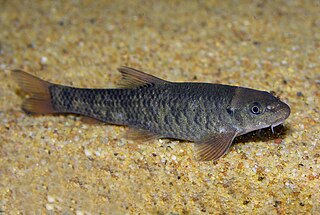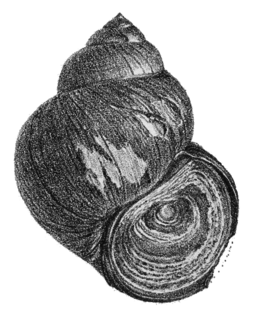
Cyprinidae is a family of freshwater fish commonly called the carp or minnow family. It includes the carps, the true minnows, and relatives like the barbs and barbels. Cyprinidae is the largest and most diverse fish family and the largest vertebrate animal family in general with about 3,000 species, of which only 1,270 remain extant, divided into about 370 genera. Cyprinids range from about 12 mm in size to the 3-m giant barb. By genus and species count, the family makes up more than two-thirds of the ostariophysian order Cypriniformes. The family name is derived from the Greek word kyprînos.

Rhodeus is a genus of cyprinid fish, consisting of 23 species called bitterlings. The scientific name is derived from the Greek word rhodeos, meaning "rose". Most species in the genus are restricted to Asia, but two species are found in Europe.

Sisoridae is a family of catfishes. These Asian catfishes live in fast-moving waters and often have adaptations that allow them to adhere to objects in their habitats. The family includes about 235 species.

The rosy bitterling or Tairiku baratanago is a small freshwater fish belonging to the family Cyprinidae (carp), native to East Asia from the Amur River basin to the Pearl River basin.
Sinocyclocheilus is a genus of freshwater fish in the family Cyprinidae endemic to China, where only found in Guangxi, Guizhou and Yunnan. Almost all of its species live in or around caves and most of these have adaptions typical of cavefish such as a lack of scales, lack of pigmentation and reduced eyes. Several species have an unusual hunchbacked appearance and some of the cave-dwellers have a "horn" on the back, the function of which is unclear. In contrast, the Sinocyclocheilus species that live aboveground, as well as a few found underground, show no clear cavefish adaptions. They are relatively small fish reaching up to 23 cm (9.1 in) in length. The individual species have small ranges and populations, leading to the status of most of the evaluated species as threatened. Many species populations in the genus have yet to be evaluated by the IUCN.
Rhodeus amurensis is a temperate freshwater fish belonging to the Acheilognathinae subfamily of the family Cyprinidae. It originates in the Amur River and Lake Khanka in Asia, and is found in China and Russia. It was originally described as Pseudoperilampus lighti amurensis by B.B. Vronsky in 1967, and has also been referred to in scientific literature as Rhodeus lighti amurensis.
Rhodeus fangi is a subtropical freshwater fish belonging to the Acheilognathinae subfamily of the family Cyprinidae. It originates in the Pearl River, Yangtze River in China. It was originally described as Pararhodeus fangi by C.P. Miao in 1934.

The European bitterling is a temperate freshwater fish belonging to the subfamily Acheilognathinae of the family Cyprinidae. It originates in Europe, ranging from the Rhone River basin in France to the Neva River in Russia. It was originally described as Cyprinus amarus by Marcus Elieser Bloch in 1782, and has been referred to in scientific literature as Rhodeus sericeus amarus. It is known simply as "the bitterling" in its native range, where it is the only species of its genus Rhodeus, and sometimes in the scientific literature, also, but this is technically wrong, being a leftover from the times when the European bitterling was united with its Siberian relative, the Amur bitterling, in R. sericeus. Properly, "bitterling" can refer to any species of Acheilognathus or Rhodeus.

Light's bitterling is a temperate freshwater fish belonging to the subfamily Acheilognathinae of the family Cyprinidae. It originates in Russia and China, from the Amur River basin to southern China. It was originally described as Pseudoperilampus lighti by H.W. Wu in 1931.

Rhodeus sinensis is a subtropical freshwater fish belonging to the Acheilognathinae subfamily of the family Cyprinidae. It originated in inland rivers in China, and has been introduced as an exotic species in Afghanistan. The fish reaches a length up to 5.2 cm (2.0 in), and is native to freshwater habitats with a pH of 6.8 to 7.8, a hardness of 20 DH, and a temperature of 10 to 25 °C. When spawning, the females deposit their eggs inside bivalves, where they hatch and the young remain until they can swim.

Rhodeus smithii, sometimes known as the Japanese rosy bitterling, Japanese bitterling, or Nippon baratanago is a temperate freshwater fish belonging to the Acheilognathinae subfamily of the family Cyprinidae. It originates in stagnant waters in inland rivers in Japan. It was originally described as Achilognathus smithii by Charles Tate Regan in 1908, and is also referred to as Rhodeus ocellatus smithii in scientific literature.

Pseudobagrus is a genus of bagrid catfishes that inhabit streams and rivers throughout East Asia. About half of these species occur in China.

Garra is a genus of fish in the family Cyprinidae. These fish are one example of the "log suckers", sucker-mouthed barbs and other cyprinids commonly kept in aquaria to keep down algae. The doctor fish of Anatolia and the Middle East belongs in this genus. The majority of the more than 140 species of garras are native to Asia, but about one-fifth of the species are from Africa.

Schistura is a genus of fish in the stone loach family Nemacheilidae native to the streams and rivers of the southern and eastern Asia. Some of these species are troglobitic.

The bitterling-like cyprinids form the cyprinid subfamily Acheilognathinae. This subfamily contains four genera, although the Khanka spiny bitterling is often placed in Acheilognathus, and at least 71 described species to date. Over half of the species are in the genus Acheilognathus.

Li Sizhong was an ichthyologist with the Institute of Zoology (中国科学院动物研究所) at the Chinese Academy of Sciences. Throughout his research career, he made numerous discoveries of new fish species, and published many books and research papers describing the fauna and geographical distribution of fishes in China and beyond. He translated and helped publication of the Chinese editions of Fishes of the World and Fish Migration. Li was the major author of two published volumes in the Fauna Sinica monograph series, systematically reviewing and describing orders of bony fishes that include flat fish, cod, silverside, pearlfish, killifish, flying fish, etc. in or near China. He had written over 40 popular science articles about fish on Chinese newspapers and magazines, and been responsible for compiling and editing fish-related entries in several standard reference books.

Cipangopaludina cathayensis is a species of large, freshwater snail with an operculum and a gill, an aquatic gastropod mollusk in the family Viviparidae, the river snails.
Rhodeus shitaiensis is a species of freshwater ray-finned fish in the genus Rhodeus. It is endemic to China, where it is found in the Qiupu River of the Yangtze River drainage.
Sinorhodeus microlepis (Chinese:细鳞华鳑鲏) is a bitterling native to the Yangtze river in Chongqing City, China, and it is the only member of the genus Sinorhodeus. This species breeds in the Asian clam, which is different from all other bitterling-like cyprinids.
Yang Jun-Xing is a Chinese herpetologist and ichthyologist with the Kunming Institute of Zoology. As of 2018, Yang authored 9 species of fish and amphibians.












